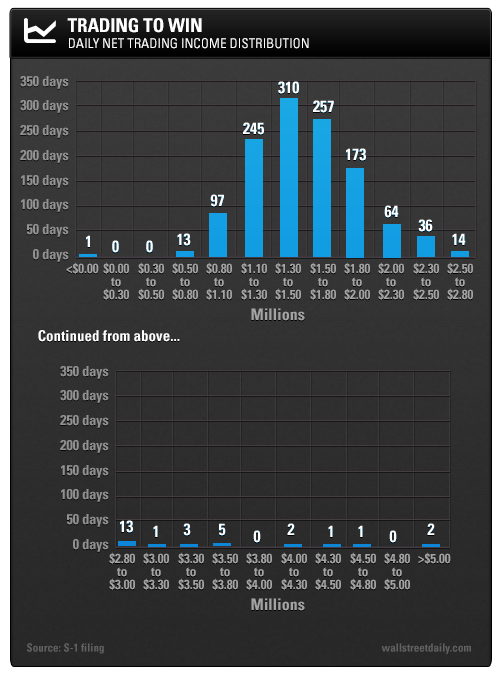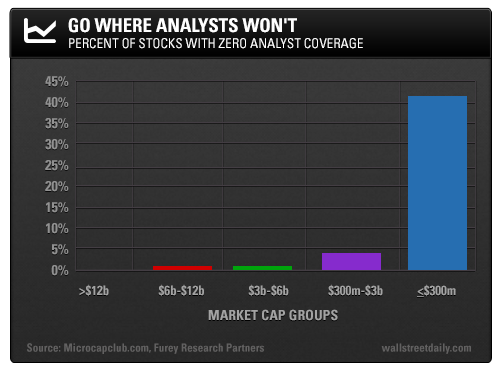Prepare to be stupefied…
Over the course of 1,238 trading days – from January 1, 2009 to December 31, 2013 – Virtu Financial had one day in which it lost money. One!
Let that sink in for a moment… 1,237 days of profits and only one day of losses.
And we thought J.P. Morgan’s (JPM) stretch of 365 days of trading without a loss was impressive?
I assure you, this isn’t the stuff of Bernie Madoff. It’s not a statistical anomaly. It’s the stuff of high frequency trading (HFT). And it’s totally legit.
Today, I want to share two ways you can get a piece of the action. So let’s get to it…
Believe the Hype
On Monday, New York City-based Virtu Financial filed IPO plans with the SEC to raise up to $100 million. Although no date has been set yet, it plans to list on the Nasdaq under the ticker VIRT.
And it’s in the IPO prospectus where we find this mind-blowing chart, showing the company’s daily net trading income.

You’ll note, there was only one day, during 2012, when the firm lost money. Every other day, Virtu pocketed anywhere from $500,000 to upwards of $5 million in profit.
Such a hefty daily haul explains the $624 million in “trading income” the company reported last year, as well as the founder’s $114 million NYC mansion.
So how does the company do it?
Per the S-1: “We stand ready, at any time, to buy or sell a broad range of securities, and we generate revenue by buying and selling large volumes of securities and other financial instruments and earning small bid/ask spreads.”
To be clear, the company doesn’t speculate. Instead, its strategies are “designed to lock in returns through precise and nearly instantaneous hedging.”
It simply provides liquidity, scalping pennies on billions of market orders, which clearly add up over time.
Here’s the most shocking revelation in the S-1: “If our risk management system detects a trading strategy generating revenues outside of our preset limits, it will freeze, or ‘lockdown,’ that strategy and alert risk management personnel and management.”
In other words, if the company is making too much money in a particular market, it shuts down trading, just to be safe. Don’t we all wish we had that problem?
If You Can’t Beat ‘Em…
Virtu’s runaway success reveals something we’ve known for a long time: Markets aren’t even close to being efficient. If they were, Virtu couldn’t survive – let alone thrive.
Despite what you’ve been told to the contrary, even the most liquid and widely traded securities aren’t efficient.
Case in point: On March 3, the bid-ask spread on the SPDR S&P 500 ETF (SPY) became inverted for 500 milliseconds, according to Cristian Zarcu of TradeDynamiX.
That means the bid price was above the ask price for half a second. Not by a little bit, either. At one point, the spread reached as high as $0.09 ($184.24 versus $184.15).
In a world where HFTs like Virtu can trade inefficiencies down to the millisecond, this represented a free lunch.
And if this is going on in an ETF that sees the heaviest trading, rest assured, it’s going on elsewhere in the market, too.
So how can we compete against the “can’t lose” profit machines that are HFTs? We have two options:
We can either concede defeat and invest right alongside them by buying into Virtu’s IPO. (Yes, I’ll let you know when the stock begins trading.)
Or we can go where HFTs can’t – micro caps.
As my friend and fellow micro-cap specialist, Ian Cassel, points out, they represent the last inefficient market cap class where individual investors like us hold a distinct advantage.
How so? Well, Wall Street analysts routinely ignore micro caps. In fact, over 40% of companies with market caps of less than $300 million have no analyst coverage. That allows us to uncover meaningful information first – before it’s reflected in share prices.

At the same time, daily trading volume in micro caps is way too infrequent for HFTs to even bother.
Bottom line: Although we can’t duplicate the exact trading successes of companies like Virtu, we can generate more than enough profits in micro caps to make it worthwhile.
